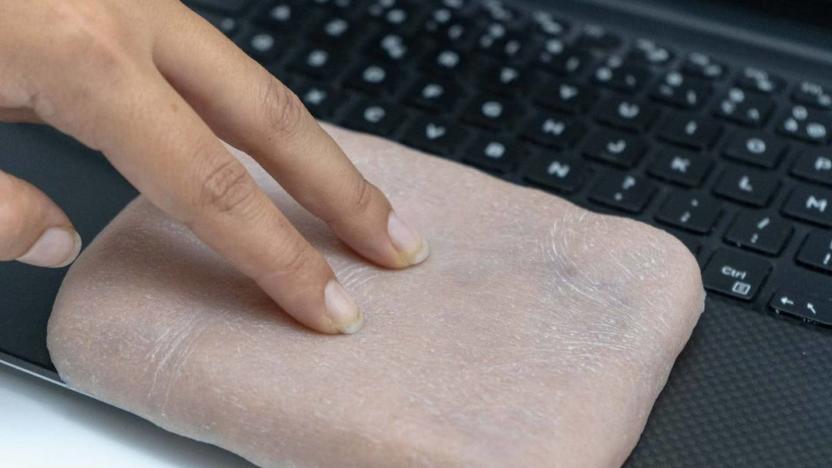artificial skin
Latest

Researchers built robotic skin with a sense of touch
Using Intel's neuromorphic Loihi chip, researchers created a robotic skin that detects touch more than 1,000 times faster than the human sensory nervous system.

Researchers create an artificial skin that makes your phone ticklish
We're so reliant on our smartphones that it's probably fair to say they've become an extension of ourselves, so the fact that scientists have now developed an artificial "skin" for our devices -- that has the ability to make them ticklish -- is not a huge surprise. Horrifying, maybe, but it was only a matter of time.

Canadian researchers aim to build a more life-like robot, one piece at a time
It may not be all that human-like in its current state, but a team of researchers at the University of Ottawa are promising that this robot will get there sooner or later. Dubbed "Pumpkin," the bot will apparently have its parts replaced piece-by-piece with more life-like counterparts over time, including parts that make use of a new artificial skin the researchers have developed. It not only includes the usual array of sensors that give the robot some degree of tactile sensitivity, but a network of tubes that circulate hot water to actually increase the temperature of the skin. According to the researchers, the eventual goal is to have a robot that appears and behaves naturally enough to make humans feel at ease when they're interacting with it, but it might get a bit worse before it gets better -- the next step is to replace the head with an anatomically correct model of the human skull, which will have the aforementioned artificial skin stretched over it. [Thanks, Jeff]

Stanford builds super-stretchy skin sensor out of carbon nanotubes (video)
An artificial skin that senses pressure, pinches and touch sounds like a macguffin from The Outer Limits (the episode "Valerie 23" if we recall correctly), but that's what a team from Stanford University has cooked up on the back of its pick-up truck. Sensors made of silicon films with a matrix of liquid carbon nanotubes ensure the material snaps back to its original shape no matter how frequently it's pulled about. When compressed, the electrical conductivity of the skin changes, and by measuring where and by how much, it knows the location and pressure of where you jab your fingers. The team wants to combine this super stretchy film with a much more sensitive sensor and if it can do it, then the technology could end up as an artificial skin for burn victims, covering prosthetic limbs or even replacing your multitouch display -- just be careful, you might hurt Siri if you pinch-to-zoom her too hard.

UC Berkeley researchers craft ultra-sensitive artificial skin, robots dream of holding eggs
Researchers and engineers have been toiling on synthetic skins for years now, but most of 'em have run into one major problem: the fact that organic materials are poor semiconductors. In other words, older skins have required high levels of power to operate, and those using inorganic materials have traditionally been too fragile for use on prosthetics. Thanks to a team of researchers at UC Berkeley, though, we're looking at a new "pressure-sensitive electronic material from semiconductor nanowires." The new 'e-skin' is supposedly the first material made out of inorganic single crystalline semiconductors, and at least in theory, it could be widely used in at least two applications. First off, robots could use this skin to accurately determine how much force should be applied (or not applied, as the case may be) to hold a given object. Secondly, this skin could give touch back to those with artificial hands and limbs, though that would first require "significant advances in the integration of electronic sensors with the human nervous system. Dollars to donuts this gets tested on the gridiron when UCLA and / or Stanford comes to town.




